Tensile Properties of Curaua–Aramid Hybrid Laminated Composites for Ballistic Helmet
Abstract
:1. Introduction
2. Materials and Methods
2.1. Materials
2.2. Composites Production
2.3. Uniaxial Tensile Test
2.4. Impact Test
3. Results and Discussion
3.1. Tensile Properties
3.2. Reduction Maps
3.3. Impact Test Results
3.4. Tensile Rupture Mechanisms
4. Summary and Conclusions
- Except for the tensile deformation at the rupture, the ultimate stress (UTS), elastic modulus, toughness, and absorbed impact energy decreased with an increasing amount of curaua substitution for aramid layers.
- Proposed Reduction Maps revealed a percentage loss in UTS (~40%) and toughness in volume percentage (29%) of the aramid, which corresponds to a disadvantageous substitution of four layers of the aramid by one layer of curaua.
- On the contrary, the percentage of reduction in all tensile properties for the substitution of 9 and 14 layers of the aramid by, respectively, 2 and 3 layers of curaua was found advantageous. In particular, the composite with a ~33 vol.% of the aramid (10 layers) and ~32 vol.% of curaua (2 layers) in a ~35 vol.% epoxy matrix were the most promising for ballistic helmet.
- The absence of a delamination mechanism in the rupture of curaua layers contributes to an increase in deformation to the rupture, associated with a more plastic hybrid composite and possibly an improved ballistic performance
Author Contributions
Funding
Institutional Review Board Statement
Informed Consent Statement
Data Availability Statement
Acknowledgments
Conflicts of Interest
References
- Folgar, F. Thermoplastic Matrix Combat Helmet with Carbon-Epoxy Skin for Ballistic Performance. In Advanced Fibrous Composite Materials for Ballistic Protection; Chen, X., Ed.; Woodhead Publishing: Cambridge, UK, 2016; pp. 877–920. [Google Scholar] [CrossRef]
- Walsh, S.M.; Scott, B.R.; Jones, T.L.; Cho, K.; Wolbert, J. A Materials Approach in the Development of Multi-Threat Warfighter Head Protection; U.S. Army Research Laboratory, Aberdeen Proving Ground, EUA: Harford County, MD, USA, 2008. [Google Scholar]
- Meliande, N.M. Characterization of Hybrid Epoxy Matrix Composites with Aramid Fabric and Curaua Mat for Ballistic Helmet. Master’s Thesis, Military Institute of Engineering, Rio de Janeiro, Brazil. January 2022 (In Portuguese).
- Kulkarni, S.G.; Gao, X.L.; Horner, S.E.; Zheng, J.Q.; David, N.V. Ballistic Helmets—Their Design, Materials, and Performance against Traumatic Brain Injury. Compos. Struct. 2013, 101, 313–331. [Google Scholar] [CrossRef] [Green Version]
- Hamouda, A.M.S.; Sohaimi, R.M.; Zaidi, A.M.A.; Abdullah, S. Materials and Design Issues for Military Helmets. In Advances in Military Textiles and Personal Equipment; Sparks, E., Ed.; Woodhead Publishing Limited in association with The Textile Institute: Cambridge, UK, 2012; pp. 242–307 . [Google Scholar] [CrossRef]
- Xian, G.; Guo, R.; Li, C. Combined effects of sustained bending loading, water immersion and fiber hybrid mode on the mechanical properties of carbon/glass fiber reinforced polymer composite. Compos. Struct. 2022, 281, 11506. [Google Scholar] [CrossRef]
- Guo, R.; Xian, G.; Li, C.; Huang, X.; Xin, M. Effect of fiber hybridization types on the mechanical properties of carbon/glass fiber reinforced polymer composite rod. Mech. Adv. Mater. Struct. 2021, 1–13. [Google Scholar] [CrossRef]
- Fan, W.; Dang, W.; Liu, T.; Li, J.; Xue, L.; Yuan, L.; Dong, J. Fatigue behavior of the 3D orthogonal carbon/glass fiber hybrid composite under these point bending load. Mater. Des. 2019, 183, 108112. [Google Scholar] [CrossRef]
- Monteiro, S.N.; Lopes, F.P.D.; Ferreira, A.S.; Nascimento, D.C.O. Natural-Fiber Polymer-Matrix Composites: Cheaper, Tougher, and Environmentally Friendly. JOM 2009, 61, 17–22. [Google Scholar] [CrossRef]
- Aisyah, H.A.; Paridah, M.T.; Sapuan, S.M.; Ilyas, R.A.; Khalina, A.; Nurazzi, N.M.; Lee, S.H.; Lee, C.H. A comprehensive review on advanced sustainable woven natural fibre polymer composites. Polyms 2021, 13, 471. [Google Scholar] [CrossRef]
- Karimah, A.; Ridho, M.R.; Minawar, S.S.; Adi, D.S.; Damayanti, R.; Subiyanto, B.; Fatriasari, W.; Fudholi, A. A review of natural fibers development of ecofriendly bio-composite: Characteristics and utilization. J. Mater. Res. Technol. 2021, 13, 2442–2458. [Google Scholar] [CrossRef]
- Li, M.; Pu, Y.; Thomas, V.M.; Yoo, C.G.; Ozcan, S.; Deng, Y.; Nelson, K.; Ragauskas, A.J. Recent advancements of plant-based natural fiber–reinforced composites and their applications. Comps. Part B Eng. 2020, 200, 108254. [Google Scholar] [CrossRef]
- Vigneshwaran, S.; Sundarakannan, R.; John, K.M.; Johnson, R.D.J.; Prasath, K.A.; Ajith, S.; Arumugaprabu, V.; Uthayakumar, M. Recent advancement in the natural fiber polymer composites: A comprehensive review. J. Clean Product. 2020, 277, 124109. [Google Scholar] [CrossRef]
- Zhang, Z.; Cai, S.; Li, Y.; Wang, Z.; Long, Y.; Yu, T.; Shen, Y. High performances of plant fiber reinforced composites-A new insight from hierarchical microstructures. Compos. Sci. Technol. 2020, 190, 108151. [Google Scholar] [CrossRef]
- Luz, F.S.; Garcia-Filho, F.D.C.; Del-Rio, M.T.G.; Nascimento, L.F.C.; Pinheiro, W.A.; Monteiro, S.N. Graphene-incorporated natural fibers polymers composites: A first overview. Polymers 2020, 12, 1601. [Google Scholar] [CrossRef] [PubMed]
- Ahmad, F.; Choi, H.S.; Park, M.K. A Review: Natural Fiber Composites Selection in View of Mechanical, Light Weight, and Economic Properties. Macromol. Mater. Eng. 2015, 300, 10–24. [Google Scholar] [CrossRef]
- Ferreira, M.Z.; Pupo, H.F.; Cherian, B.M.; Leão, A.L. The Use of Curaua Fibers as Reiforcements in Composites. In Biofiber Reinforcement in Composite Materials; Faruk, O., Sain, M., Eds.; Woodhead Publishing: Cambridge, UK, 2015; pp. 1260–1298 . [Google Scholar]
- Zah, R.; Hischier, R.; Leão, A.L.; Braun, I. Curauá Fibers in the Automobile Industry—A Sustainability Assessment. J. Clean. Prod. 2007, 15, 1032–1040. [Google Scholar] [CrossRef]
- Monteiro, S.N.; Lopes, F.P.D.; Barbosa, A.P.; Bevitori, A.B.; Amaral Da Silva, I.L.; Da Costa, L.L. Natural Lignocellulosic Fibers as Engineering Materials-an Overview. Metall. Mater. Trans. A Phys. Metall. Mater. Sci. 2011, 42, 2963–2974. [Google Scholar] [CrossRef] [Green Version]
- Koronis, G.; Silva, A.; Fontul, M. Green Composites: A Review of Adequate Materials for Automotive Applications. Compos. Part B Eng. 2013, 44, 120–127. [Google Scholar] [CrossRef]
- Faruk, O.; Bledzki, A.K.; Fink, H.P.; Sain, M. Biocomposites Reinforced with Natural Fibers: 2000–2010. Prog. Polym. Sci. 2012, 37, 1552–1596. [Google Scholar] [CrossRef]
- Mohanty, A.K.; Misra, M.; Hinrichsen, G. Biofibres, Biodegradable Polymers and Biocomposites: An Overview. Macromol. Mater. Eng. 2000, 276, 1–24. [Google Scholar] [CrossRef]
- Gupta, M.K.; Srivstava, R.K. Mechanical properties of hybrid fibres reinforced polymers composites: A review. Polym-Plant. Technol. Eng. 2015, 55, 626–642. [Google Scholar] [CrossRef]
- Rahman, R.; Putra, S.Z.F.S. Tensile properties of natural and synthetic fiber-reinforced polymer composites. In Mechanical and Physical Testing of Biocomposites, Fibre-Reinforced Composites and Hybrid Composites; Woodhead Publishing Series in Composites Science and Engineering; Woodhead Publishing: Cambridge, UK, 2019; pp. 81–102. [Google Scholar] [CrossRef]
- Nayak, S.; Jesthi, D.K.; Saroj, S.; Sadarang, J. Assessment of impact and hardness property of natural fiber and glass fiber hybrid polymer composite. Mater. Today: Proc. 2022, 49, 497–501. [Google Scholar] [CrossRef]
- Salman, S.D.; Leman, Z.; Ishak, M.R.; Sultan, M.T.H.; Cardona, F. Quasi-Static Penetration Behavior of Plain Woven Kenaf/Aramid Reinforced Polyvinyl Butyral Hybrid Laminates. J. Ind. Text. 2018, 47, 1427–1446. [Google Scholar] [CrossRef]
- Rana, R.S.; Kumre, A.; Rana, S.; Purohit, R. Characterization of Properties of Epoxy Sisal/Glass Fiber Reinforced Hybrid Composite. Mater. Today Proc. 2017, 4, 5445–5451. [Google Scholar] [CrossRef]
- Cerbu, C.; Botiş, M. Numerical Modeling of the Flax/Glass/Epoxy Hybrid Composite Materials in Bending. Procedia Eng. 2017, 181, 308–315. [Google Scholar] [CrossRef]
- Angrizani, C.C.; Ornaghi, H.L.; Zattera, A.J.; Amico, S.C. Thermal and Mechanical Investigation of Interlaminate Glass/Curaua Hybrid Polymer Composites. J. Nat. Fibers 2017, 14, 271–277. [Google Scholar] [CrossRef]
- Salman, S.D.; Leman, Z.; Sultan, M.T.H.; Ishak, M.R.; Cardona, F. Effect of Kenaf Fibers on Trauma Penetration Depth and Ballistic Impact Resistance for Laminated Composites. Text. Res. J. 2017, 87, 2051–2065. [Google Scholar] [CrossRef]
- Sarasini, F.; Tirillò, J.; D’Altilia, S.; Valente, T.; Santulli, C.; Touchard, F.; Chocinski-Arnault, L.; Mellier, D.; Lampani, L.; Gaudenzi, P. Damage Tolerance of Carbon/Flax Hybrid Composites Subjected to Low Velocity Impact. Compos. Part B Eng. 2016, 91, 144–153. [Google Scholar] [CrossRef]
- Flynn, J.; Amiri, A.; Ulven, C. Hybridized Carbon and Flax Fiber Composites for Tailored Performance. Mater. Des. 2016, 102, 21–29. [Google Scholar] [CrossRef]
- Johnson, S.; Kang, L.; Akil, H.M. Mechanical Behavior of Jute Hybrid Bio-Composites. Compos. Part B Eng. 2016, 91, 83–93. [Google Scholar] [CrossRef] [Green Version]
- Yahaya, R.; Sapuan, S.M.; Jawaid, M.; Leman, Z.; Zainudin, E.S. Measurement of Ballistic Impact Properties of Woven Kenaf-Aramid Hybrid Composites. Meas. J. Int. Meas. Confed. 2016, 77, 335–343. [Google Scholar] [CrossRef]
- Salman, S.D.; Leman, Z.; Sultan, M.T.; Ishak, M.R.; Cardona, F. Ballistic Impact Resistance of Plain Woven. BioResources 2016, 11, 7282–7295. [Google Scholar] [CrossRef] [Green Version]
- Salman, S.D.; Sharba, M.J.; Leman, Z.; Sultan, M.T.H.; Ishak, M.R.; Cardona, F. Tension-Compression Fatigue Behavior of Plain Woven Kenaf/Kevlar Hybrid Composites. BioResources 2016, 11, 3575–3586. [Google Scholar] [CrossRef]
- Saidane, E.H.; Scida, D.; Assarar, M.; Sabhi, H.; Ayad, R. Hybridisation Effect on Diffusion Kinetic and Tensile Mechanical Behaviour of Epoxy Based Flax-Glass Composites. Compos. Part A Appl. Sci. Manuf. 2016, 87, 153–160. [Google Scholar] [CrossRef]
- Ridzuan, M.J.M.; Majid, M.S.A.; Afendi, M.; Mazlee, M.N.; Gibson, A.G. Thermal Behaviour and Dynamic Mechanical Analysis of Pennisetum Purpureum/Glass-Reinforced Epoxy Hybrid Composites. Compos. Struct. 2016, 152, 850–859. [Google Scholar] [CrossRef]
- Ramesh, M.; Palanikumar, K.; Hemachandra Reddy, K. Evaluation of Mechanical and Interfacial Properties of Sisal/Jute/Glass Hybrid Fiber Reinforced Polymer Composites. Trans. Indian Inst. Met. 2016, 69, 1851–1859. [Google Scholar] [CrossRef]
- Zuhudi, N.Z.M.; Lin, R.J.T.; Jayaraman, K. Flammability, Thermal and Dynamic Mechanical Properties of Bamboo-Glass Hybrid Composites. J. Thermoplast. Compos. Mater. 2016, 29, 1210–1228. [Google Scholar] [CrossRef]
- Yahaya, R.; Sapuan, S.M.; Jawaid, M.; Leman, Z.; Zainudin, E.S. Investigating Ballistic Impact Properties of Woven Kenaf-Aramid Hybrid Composites. Fibers Polym. 2016, 17, 275–281. [Google Scholar] [CrossRef]
- Hajiha, H.; Sain, M. High Toughness Hybrid Biocomposite Process Optimization. Compos. Sci. Technol. 2015, 111, 44–49. [Google Scholar] [CrossRef]
- Muhammad, Y.H.; Ahmad, S.; Abu Bakar, M.A.; Mamun, A.A.; Heim, H.P. Mechanical Properties of Hybrid Glass/Kenaf Fibre-Reinforced Epoxy Composite with Matrix Modification Using Liquid Epoxidised Natural Rubber. J. Reinf. Plast. Compos. 2015, 34, 896–906. [Google Scholar] [CrossRef]
- Dalbehera, S.; Acharya, S.K. Impact of Stacking Sequence on Tribological Wear Performance of Woven Jute-Glass Hybrid Epoxy Composites. Tribol.—Mater. Surfaces Interfaces 2015, 9, 196–201. [Google Scholar] [CrossRef]
- Yahaya, R.; Sapuan, S.M.; Jawaid, M.; Leman, Z.; Zainudin, E.S. Effect of Layering Sequence and Chemical Treatment on the Mechanical Properties of Woven Kenaf-Aramid Hybrid Laminated Composites. Mater. Des. 2015, 67, 173–179. [Google Scholar] [CrossRef]
- Ramachandra Reddy, G.; Ashok Kumar, M.; Karthikeyan, N.; Mahaboob Basha, S. Tamarind Fruit Fiber and Glass Fiber Reinforced Polyester Composites. Mech. Adv. Mater. Struct. 2015, 22, 770–775. [Google Scholar] [CrossRef]
- Atiqah, A.; Maleque, M.A.; Jawaid, M.; Iqbal, M. Development of Kenaf-Glass Reinforced Unsaturated Polyester Hybrid Composite for Structural Applications. Compos. Part B Eng. 2014, 56, 68–73. [Google Scholar] [CrossRef]
- Yahaya, R.; Sapuan, S.M.; Jawaid, M.; Leman, Z.; Zainudin, E.S. Quasi-Static Penetration and Ballistic Properties of Kenaf-Aramid Hybrid Composites. Mater. Des. 2014, 63, 775–782. [Google Scholar] [CrossRef]
- Bakkal, M.; Savas, M. Development of Natural Fiber Reinforced Laminated Hybrid Composites. Adv. Mater. Res. 2012, 628, 15–20. [Google Scholar] [CrossRef]
- Hashmi, S.A.R.; Naik, A.; Chand, N.; Sharma, J.; Sharma, P. Development of Environment Friendly Hybrid Layered Sisal-Glass-Epoxy Composites. Compos. Interfaces 2011, 18, 671–683. [Google Scholar] [CrossRef]
- Rajole, S.; Ravishankar, K.S.; Kulkarni, S.M. Performance Study of Jute-Epoxy Composites/Sandwiches under Normal Ballistic Impact. Def. Technol. 2020, 16, 947–955. [Google Scholar] [CrossRef]
- Nayak, S.Y.; Sultan, M.T.H.; Shenoy, S.B.; Kini, C.R.; Samant, R.; Shah, A.U.M.; Amuthakkannan, P. Potential of Natural Fibers in Composites for Ballistic Applications–A Review. J. Nat. Fibers 2020, 19, 1648–1658. [Google Scholar] [CrossRef]
- Garcia Filho, F.D.C.; Oliveira, M.S.; Pereira, A.C.; Nascimento, L.F.C.; Ricardo Gomes Matheus, J.; Monteiro, S.N. Ballistic Behavior of Epoxy Matrix Composites Reinforced with Piassava Fiber against High Energy Ammunition. J. Mater. Res. Technol. 2020, 9, 1734–1741. [Google Scholar] [CrossRef]
- Pereira, A.C.; de Assis, F.S.; Filho, F.D.C.G.; Oliveira, M.S.; Demosthenes, L.C.D.C.; Lopera, H.A.C.; Monteiro, S.N. Ballistic Performance of Multilayered Armor with Intermediate Polyester Composite Reinforced with Fique Natural Fabric and Fibers. J. Mater. Res. Technol. 2019, 8, 4221–4226. [Google Scholar] [CrossRef]
- de Assis, F.S.; Pereira, A.C.; Filho, F.D.C.G.; Lima, É.P.; Monteiro, S.N.; Weber, R.P. Performance of Jute Non-Woven Mat Reinforced Polyester Matrix Composite in Multilayered Armor. J. Mater. Res. Technol. 2018, 7, 535–540. [Google Scholar] [CrossRef]
- Braga, F.D.O.; Milanezi, T.L.; Monteiro, S.N.; Louro, L.H.L.; Gomes, A.V.; Lima, É.P. Ballistic Comparison between Epoxy-Ramie and Epoxy-Aramid Composites in Multilayered Armor Systems. J. Mater. Res. Technol. 2018, 7, 541–549. [Google Scholar] [CrossRef]
- Monteiro, S.N.; Pereira, A.C.; Ferreira, C.L.; Júnior, É.P.; Weber, R.P.; de Assis, F.S. Performance of Plain Woven Jute Fabric-Reinforced Polyester Matrix Composite in Multilayered Ballistic System. Polymers 2018, 10, 230. [Google Scholar] [CrossRef] [PubMed] [Green Version]
- Haro, E.E.; Szpunar, J.A.; Odeshi, A.G. Dynamic and Ballistic Impact Behavior of Biocomposite Armors Made of HDPE Reinforced with Chonta Palm Wood (Bactris Gasipaes) Microparticles. Def. Technol. 2018, 14, 238–249. [Google Scholar] [CrossRef]
- Braga, F.O.; Bolzan, L.T.; Lima, É.P.; Monteiro, S.N. Performance of Natural Curaua Fiber-Reinforced Polyester Composites under 7.62 Mm Bullet Impact as a Stand-Alone Ballistic Armor. J. Mater. Res. Technol. 2017, 6, 323–328. [Google Scholar] [CrossRef]
- Braga, F.O.; Bolzan, L.T.; Luz, F.S.; Lopes, P.H.L.M.; Lima, É.P.; Monteiro, S.N. High Energy Ballistic and Fracture Comparison between Multilayered Armor Systems Using Non-Woven Curaua Fabric Composites and Aramid Laminates. J. Mater. Res. Technol. 2017, 6, 417–422. [Google Scholar] [CrossRef]
- Da Luz, F.S.; Monteiro, S.N.; Lima, E.S.; Lima, É.P. Ballistic Application of Coir Fiber Reinforced Epoxy Composite in Multilayered Armor. Mater. Res. 2017, 20, 23–28. [Google Scholar] [CrossRef]
- De Oliveira Braga, F.; Bolzan, L.T.; Ramos, F.J.H.T.V.; Monteiro, S.N.; Lima, É.P.; Da Silva, L.C. Ballistic Efficiency of Multilayered Armor Systems with Sisal Fiber Polyester Composites. Mater. Res. 2017, 20, 767–774. [Google Scholar] [CrossRef]
- Monteiro, S.N.; Braga, F.D.O.; Lima, E.P.; Louro, L.H.L.; Drelich, J.W. Promising Curaua Fiber-Reinforced Polyester Composite for High-Impact Ballistic Multilayered Armor. Polym. Eng. Sci. 2017, 57, 947–954. [Google Scholar] [CrossRef]
- Nascimento, L.F.C.; Holanda, L.I.F.; Louro, L.H.L.; Monteiro, S.N.; Gomes, A.V.; Lima, É.P. Natural Mallow Fiber-Reinforced Epoxy Composite for Ballistic Armor Against Class III-A Ammunition. Metall. Mater. Trans. A Phys. Metall. Mater. Sci. 2017, 48, 4425–4431. [Google Scholar] [CrossRef]
- Nascimento, L.F.C.; Louro, L.H.L.; Monteiro, S.N.; Lima, É.P.; da Luz, F.S. Mallow Fiber-Reinforced Epoxy Composites in Multilayered Armor for Personal Ballistic Protection. JOM 2017, 69, 2052–2056. [Google Scholar] [CrossRef]
- Monteiro, S.N.; Candido, V.S.; Braga, F.O.; Bolzan, L.T.; Weber, R.P.; Drelich, J.W. Sugarcane Bagasse Waste in Composites for Multilayered Armor. Eur. Polym. J. 2016, 78, 173–185. [Google Scholar] [CrossRef]
- Monteiro, S.N.; Milanezi, T.L.; Louro, L.H.L.; Lima, É.P.; Braga, F.O.; Gomes, A.V.; Drelich, J.W. Novel Ballistic Ramie Fabric Composite Competing with KevlarTM Fabric in Multilayered Armor. Mater. Des. 2016, 96, 263–269. [Google Scholar] [CrossRef]
- Da Cruz, R.B.; Junior, E.P.L.; Monteiro, S.N.; Louro, L.H.L. Giant Bamboo Fiber Reinforced Epoxy Composite in Multilayered Ballistic Armor. Mater. Res. 2015, 18 (Suppl. S2), 70–75. [Google Scholar] [CrossRef] [Green Version]
- Da Luz, F.S.; Junior, E.P.L.; Louro, L.H.L.; Monteiro, S.N. Ballistic Test of Multilayered Armor with Intermediate Epoxy Composite Reinforced with Jute Fabric. Mater. Res. 2015, 18, 170–177. [Google Scholar] [CrossRef]
- Monteiro, S.N.; Louro, L.H.L.; Trindade, W.; Elias, C.N.; Ferreira, C.L.; de Sousa Lima, E.; Weber, R.P.; Miguez Suarez, J.C.; da Silva Figueiredo, A.B.H.; Pinheiro, W.A.; et al. Natural Curaua Fiber-Reinforced Composites in Multilayered Ballistic Armor. Metall. Mater. Trans. A Phys. Metall. Mater. Sci. 2015, 46, 4567–4577. [Google Scholar] [CrossRef]
- Rohen, L.A.; Margem, F.M.; Monteiro, S.N.; Vieira, C.M.F.; De Araujo, B.M.; Lima, E.S. Ballistic Efficiency of an Individual Epoxy Composite Reinforced with Sisal Fibers in Multilayered Armor. Mater. Res. 2015, 18 (Suppl. S2), 55–62. [Google Scholar] [CrossRef] [Green Version]
- Benzait, Z.; Trabzon, L. A review of recent research o materials used in polymer-matrix composites for body armor application. J. Compos. Mater. 2018, 52, 3241–3263. [Google Scholar] [CrossRef]
- ASTM D3039/D3039M; American Society for Testing Materials: West Conshohocken, PA, USA, 2017. Available online: https://standards.globalspec.com/std/4055305/astm-d3039-d3039m-17 (accessed on 19 March 2022).
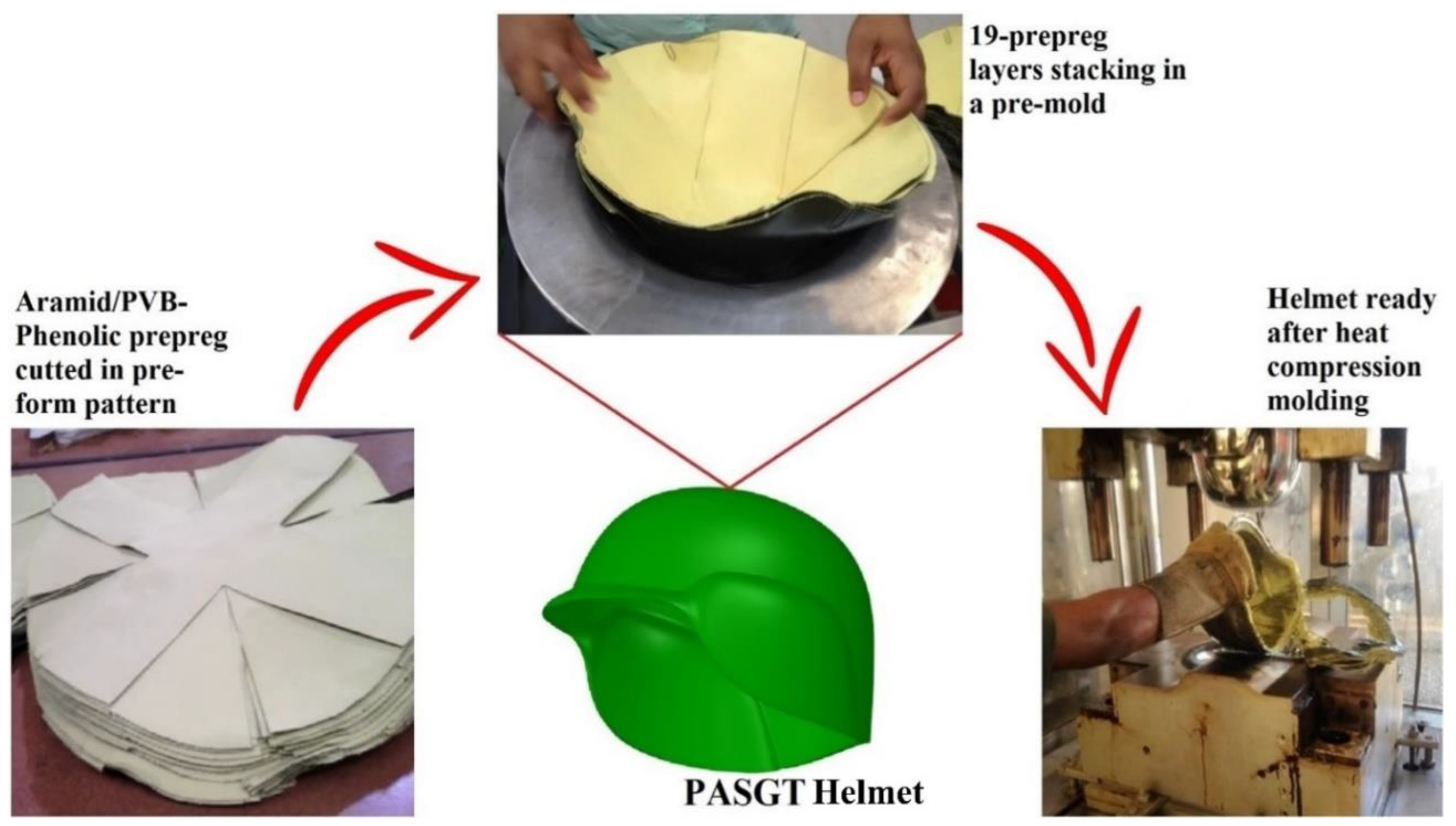
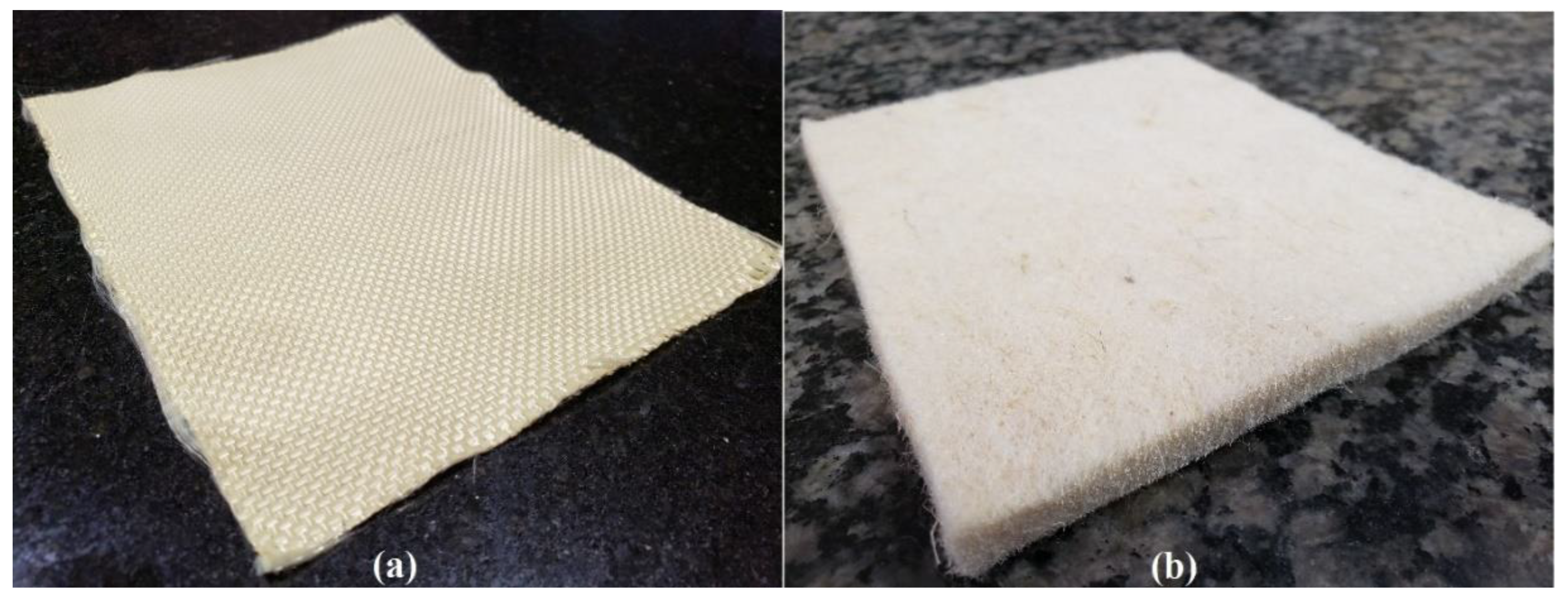
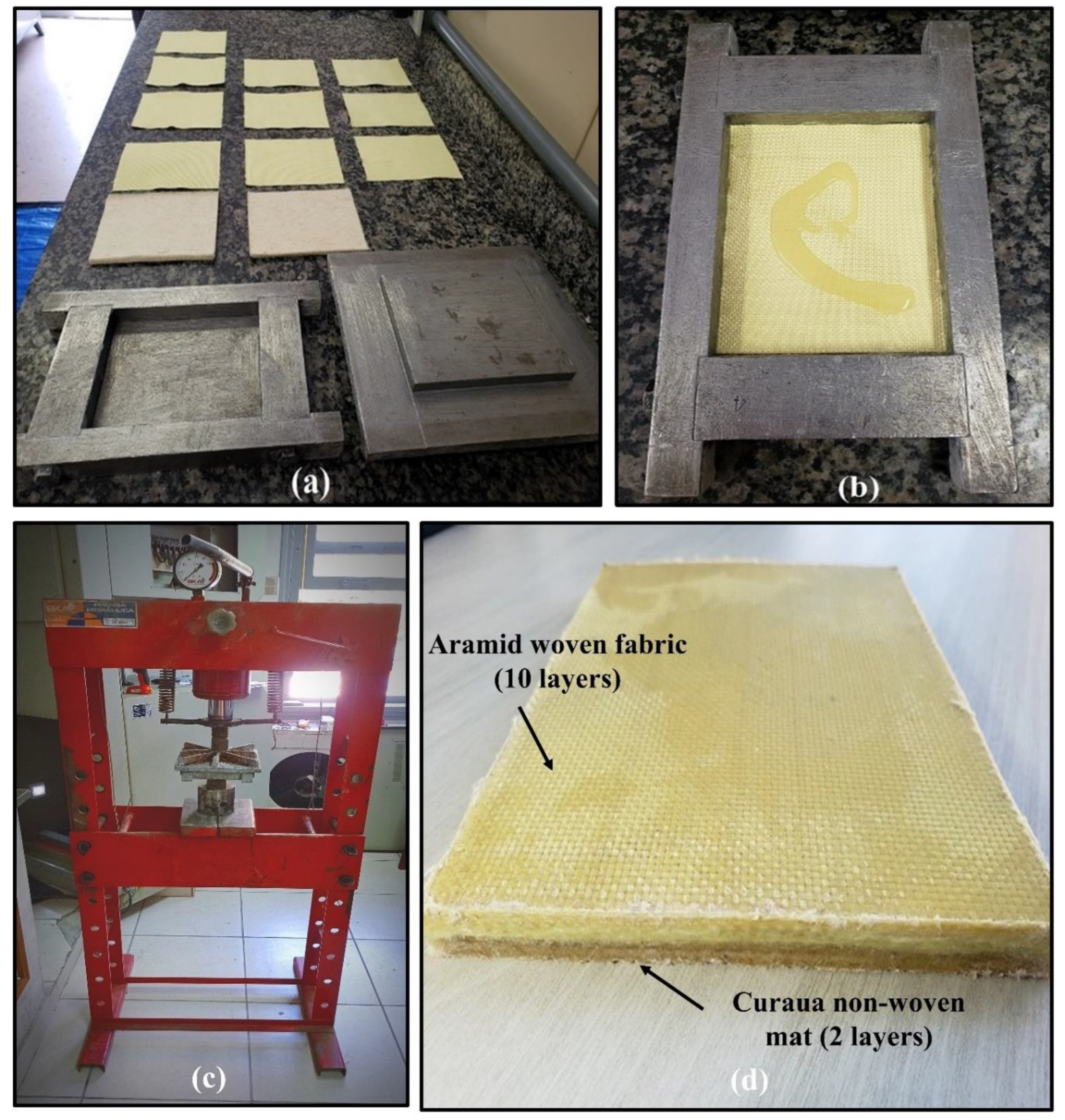

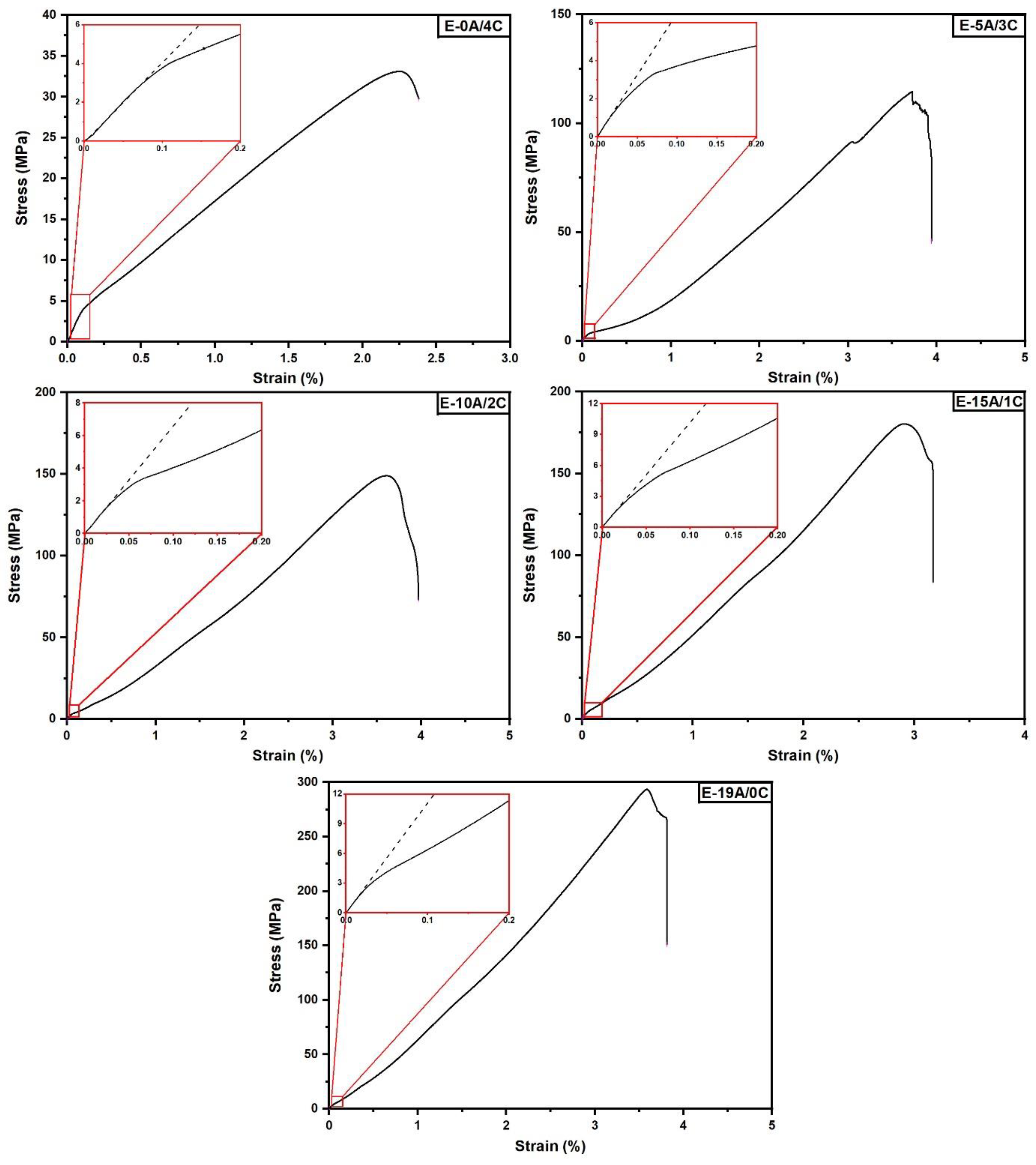

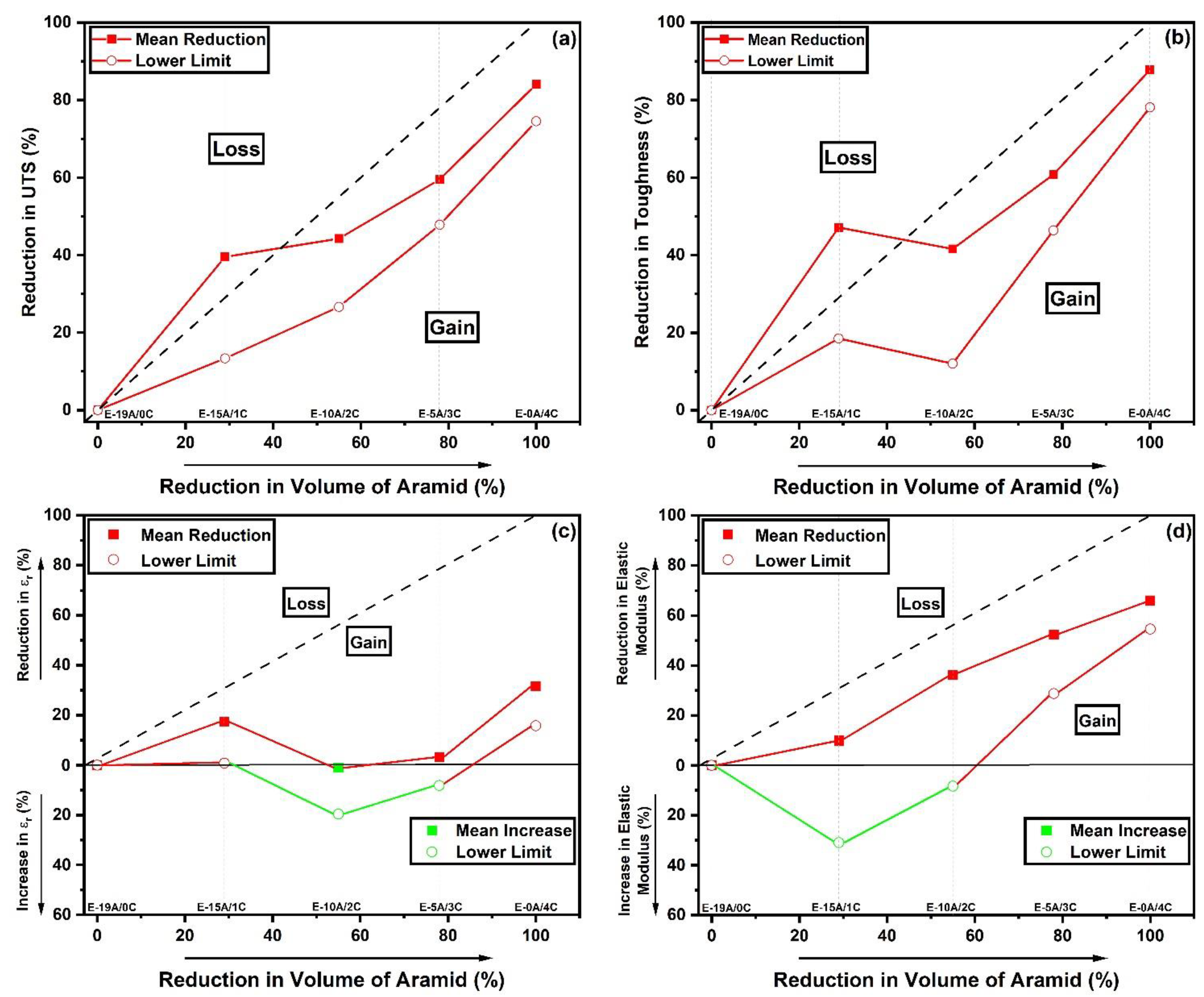

| Fiber | Density ρ (g/cm3) | Ultimate Tensile Strength UTS (MPa) | Elasticity Modulus E (GPa) | Ultimate Specific Strength UTS/ρ (MPa·cm3/g) |
|---|---|---|---|---|
| Curaua | 0.57–0.92 | 117–3000 | 27–80 | 3261 |
| E-glass | 2.50–2.58 | 2000–3450 | 70–73 | 1380 |
| Carbon | 1.78–1.81 | 2500–6350 | 230–400 | 3567 |
| Aramid | 1.44 | 3000–4100 | 63–131 | 2847 |
| Epoxy (E) Composite Configuration | Number of Layers | |
|---|---|---|
| Aramid Fabric (A) Woven Fabric | Curaua Fiber (C) Non-Woven Mat | |
| E-19A/0C | 19 | 0 |
| E-15A/1C | 15 | 1 |
| E-10A/2C | 10 | 2 |
| E-5A/3C | 5 | 3 |
| E-0A/4C | 0 | 4 |
| Composite Configuration | Weight (g) | Thickness (mm) | Vol% Total Reinforcement | Vol% Aramid | Vol% Curaua | Arealv Density (kg/m2) |
|---|---|---|---|---|---|---|
| PASGT-based | ~200 | ~8–10 | ~70 | - | - | 11.24 |
| E-19A/0C | 197.78 ± 1.41 | 8.32 ± 0.03 | 73.29 ± 0.58 | 73.29 ± 0.58 | 0 | 10.99 ± 0.07 |
| E-15A/1C | 204.65 ± 0.92 | 9.06 ± 0.04 | 68.52 ± 0.63 | 52.06 ± 0.39 | 16.47 ± 0.44 | 11.37 ± 0.51 |
| E-10A/2C | 200.47 ± 2.83 | 9.37 ± 0.08 | 65.00 ± 0.83 | 33.27 ± 0.40 | 31.73 ± 0.763 | 11.14 ± 0.16 |
| E-5A/3C | 196.14 ± 2.17 | 9.61 ± 0.13 | 61.22 ± 0.59 | 15.96 ± 0.15 | 45.26 ± 0.72 | 10.90 ± 0.12 |
| E-0A/4C | 192.41 ± 2.21 | 9.98 ± 0.12 | 57.97 ± 0.86 | 0 | 57.97 ± 0.86 | 10.69 ± 0.12 |
| Composite | Aramid Volume Reduction (%) | Ultimate Tensile Strength UTS (MPa) | Deformationat Rupture εr (%) | Elastic Modulus (GPa) | Toughness (MJ/m3) |
|---|---|---|---|---|---|
| E-19A/0C | 0 | 280.21 ± 53.79 | 3.97 ± 0.30 | 11.40 ± 1.93 | 5.41 ± 1.25 |
| E-15A/1C | 29 | 169.49 ± 26.71 | 3.28 ± 0.36 | 10.27 ± 2.18 | 2.86 ± 0.53 |
| E-10A/2C | 55 | 156.13 ± 9.93 | 4.01 ± 0.38 | 7.26 ± 1.42 | 3.16 ± 0.50 |
| E-5A/3C | 78 | 113.32 ± 4.81 | 3.84 ± 0.13 | 5.42 ± 1.33 | 2.12 ± 0.11 |
| E-0A/4C | 100 | 44.48 ± 13.11 | 2.71 ± 0.38 | 3.87 ± 0.43 | 0.66 ± 0.25 |
| E-0A/4C* | - | 32.04 ± 1.44 | 2.38 ± 0.11 | 3.70 ± 0.38 | 0.43 ± 0.02 |
| E-0A/4C** | - | 56.92 ± 2.20 | 3.04 ± 0.20 | 4.05 ± 0.43 | 0.89 ± 0.06 |
| Mean Treatment Squares | Mean Residue Squares | F (Calculated) | Fcritic (Tabulated 1) | q (Tabulated 2) | MSD |
|---|---|---|---|---|---|
| 89,444.46 | 780.08 | 114.66 | 2.54 | 3.99 | 32.21 |
| Mean Treatment Squares | Mean Residue Squares | F (Calculated) | Fcritic (Tabulated 1) | q (Tabulated 2) | MSD |
|---|---|---|---|---|---|
| 3.75 | 0.10 | 35.71 | 2.54 | 3.99 | 0.37 |
| Mean Treatment Squares | Mean Residue Squares | F (Calculated) | Fcritic (Tabulated 1) | q (Tabulated 2) | MSD |
|---|---|---|---|---|---|
| 35.94 | 0.43 | 82.81 | 2.54 | 3.99 | 0.76 |
| Mean Treatment Squares | Mean Residue Squares | F (Calculated) | Fcritic (Tabulated 1) | q (Tabulated 2) | MSD |
| 121.02 | 2.49 | 48.60 | 2.54 | 3.99 | 1.82 |
| Composite | Absorbed Impact Energy (kJ/m) |
|---|---|
| E-19A/0C | 10.32 |
| E-15A/1C | 9.72 |
| E-10A/2C | 6.29 |
| E-5A/EC | 3.86 |
| E-0A/4C | 1.34 |
Publisher’s Note: MDPI stays neutral with regard to jurisdictional claims in published maps and institutional affiliations. |
© 2022 by the authors. Licensee MDPI, Basel, Switzerland. This article is an open access article distributed under the terms and conditions of the Creative Commons Attribution (CC BY) license (https://creativecommons.org/licenses/by/4.0/).
Share and Cite
Meliande, N.M.; Silveira, P.H.P.M.d.; Monteiro, S.N.; Nascimento, L.F.C. Tensile Properties of Curaua–Aramid Hybrid Laminated Composites for Ballistic Helmet. Polymers 2022, 14, 2588. https://doi.org/10.3390/polym14132588
Meliande NM, Silveira PHPMd, Monteiro SN, Nascimento LFC. Tensile Properties of Curaua–Aramid Hybrid Laminated Composites for Ballistic Helmet. Polymers. 2022; 14(13):2588. https://doi.org/10.3390/polym14132588
Chicago/Turabian StyleMeliande, Natalin Michele, Pedro Henrique Poubel Mendonça da Silveira, Sergio Neves Monteiro, and Lucio Fabio Cassiano Nascimento. 2022. "Tensile Properties of Curaua–Aramid Hybrid Laminated Composites for Ballistic Helmet" Polymers 14, no. 13: 2588. https://doi.org/10.3390/polym14132588
APA StyleMeliande, N. M., Silveira, P. H. P. M. d., Monteiro, S. N., & Nascimento, L. F. C. (2022). Tensile Properties of Curaua–Aramid Hybrid Laminated Composites for Ballistic Helmet. Polymers, 14(13), 2588. https://doi.org/10.3390/polym14132588








